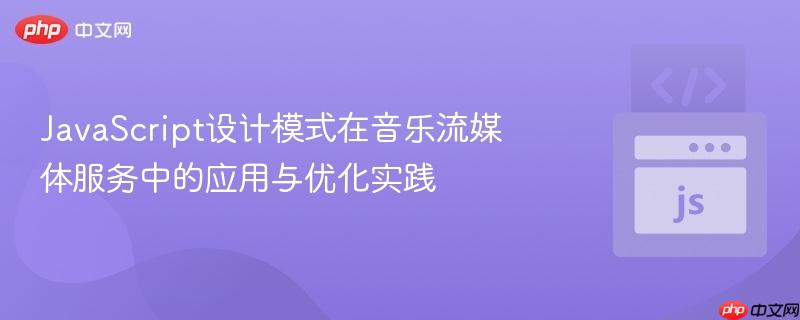
本文深入探讨了在javascript音乐流媒体服务开发中,如何运用策略、工厂、观察者、组合和外观等多种设计模式来构建模块化、可维护的系统。文章不仅详细分析了每种模式的具体实现及其在系统中的作用,更结合专业反馈,提出了关于避免过度设计、拥抱javascript语言特性以及优化代码可读性的重要建议,旨在指导开发者在实际项目中平衡设计模式的应用与代码的简洁性与效率。
javaScript设计模式在音乐流媒体服务中的应用与优化实践
设计模式是软件工程中经过验证的解决方案,用于解决在特定上下文中反复出现的设计问题。在构建复杂的javascript应用程序,如音乐流媒体服务时,合理运用设计模式能够显著提升代码的结构性、可维护性和可扩展性。本文将通过一个音乐流媒体服务的示例,详细解析多种设计模式的应用,并结合实践经验,探讨如何优化设计,避免过度工程化。
核心业务实体:歌曲(Song)
首先,我们定义音乐流媒体服务中最基本的实体——歌曲。
class Song { constructor(title, artist, format) { this.title = title; this.artist = artist; this.format = format; // 例如: "MP3", "WAV" } }
Song 类封装了歌曲的基本属性,如标题、艺术家和文件格式,为后续的播放和管理功能奠定了基础。
策略模式:处理多样化的音频格式
音乐文件有多种格式(MP3、WAV等),每种格式的解码方式可能不同。策略模式允许我们定义一系列算法,将它们封装起来,并使它们可以相互替换。
立即学习“Java免费学习笔记(深入)”;
// Decoder.js (策略模式 - 抽象策略) class Decoder { decode(format) { return `Decoding ${format} format...`; } } // 具体策略:MP3解码器 class Mp3Decoder extends Decoder { decode(format) { return `Decoding MP3 format: ${format}...`; } } // 具体策略:WAV解码器 class WavDecoder extends Decoder { decode(format) { return `Decoding WAV format: ${format}...`; } }
在这里,Decoder 是抽象策略,定义了解码操作的接口。Mp3Decoder 和 WavDecoder 是具体策略,实现了各自格式的解码逻辑。当需要支持新的音频格式时,只需创建新的具体解码器类即可,无需修改现有代码。
工厂模式:简化解码器创建
为了避免客户端代码直接实例化具体的解码器类,我们引入工厂模式。工厂模式提供了一个接口,用于创建相关或依赖对象的家族,而无需明确指定具体类。
// DecoderFactory.js (工厂模式) class DecoderFactory { createDecoder(format) { switch (format) { case "MP3": return new Mp3Decoder(); case "WAV": return new WavDecoder(); default: throw new Error(`Decoder not available for format: ${format}`); } } }
DecoderFactory 根据传入的格式参数,负责创建相应的解码器实例。这使得解码器的创建过程与使用过程解耦,提高了系统的灵活性和可维护性。
观察者模式:实时更新播放状态
在音乐播放器中,当播放状态发生变化时(例如,歌曲开始播放),用户界面或其他组件可能需要同步更新。观察者模式定义了一种一对多的依赖关系,让多个观察者对象同时监听某一个主题对象。当主题对象状态发生变化时,它会通知所有观察者,使它们能够自动更新。
// MusicPlayer.js (观察者模式 - 主题/发布者) class MusicPlayer { constructor() { this.observers = []; } play(song) { const message = `Playing song: ${song.title} - ${song.artist}`; this.notifyObservers(); // 通知所有观察者 return message; } registerObserver(observer) { this.observers.push(observer); } removeObserver(observer) { const index = this.observers.indexOf(observer); if (index !== -1) { this.observers.splice(index, 1); } } notifyObservers() { this.observers.forEach((observer) => console.log(observer.update())); } } // Observer.js (观察者模式 - 观察者) class Observer { constructor() { this.subject = null; } setSubject(subject) { this.subject = subject; this.subject.registerObserver(this); // 注册自身为观察者 } update() { // ui更新逻辑,例如:更新播放进度条、显示当前歌曲信息 return "Updating UI..."; } }
MusicPlayer 作为主题,维护一个观察者列表,并在播放状态改变时通知它们。Observer 是具体的观察者,当接收到通知时执行更新UI的逻辑。
注意事项与优化建议: 在JavaScript中,对于简单的事件通知,可以考虑使用原生的事件机制(如 EventTarget 和 CustomEvent),这通常比手动实现观察者模式更符合语言习惯,且代码更简洁。例如:
// 使用原生事件机制的MusicPlayer class MusicPlayerEvent extends EventTarget { play(song) { const message = `Playing song: ${song.title} - ${song.artist}`; this.dispatchEvent(new CustomEvent('playbackchange', { detail: { song, status: 'playing' } })); return message; } // ... 其他播放控制方法 } // 监听播放事件 const player = new MusicPlayerEvent(); player.addEventListener('playbackchange', (event) => { console.log(`UI Updated: ${event.detail.song.title} is ${event.detail.status}`); });
这种方式将通知机制内建于浏览器或node.js环境,减少了手动管理观察者列表的开销。
组合模式:构建灵活的播放列表
播放列表可以包含多首歌曲,也可以包含其他子播放列表(例如,一个专辑可以看作一个播放列表)。组合模式允许你将对象组合成树形结构以表示“部分-整体”的层次结构。组合模式使得客户端对单个对象和组合对象保持一致的处理方式。
// Playlist.js (组合模式) class Playlist { constructor(name) { this.name = name; this.songs = []; // 可以包含Song对象,也可以扩展为包含Playlist对象 } addSong(song) { this.songs.push(song); } removeSong(song) { const index = this.songs.findIndex( (s) => s.title === song.title && s.artist === song.artist ); if (index !== -1) { this.songs.splice(index, 1); } } // 可以在此添加播放整个列表、获取列表总时长等方法 }
Playlist 类可以管理一组歌曲。如果需要支持嵌套播放列表,可以将 songs 数组设计为可以同时包含 Song 和 Playlist 实例,并为它们定义一个共同的接口(例如 play() 方法),从而实现组合模式的完整性。
外观模式:简化复杂子系统交互
音乐流媒体服务通常涉及多个子系统(订阅服务、播放器、解码器、播放列表等)。外观模式提供了一个统一的接口,用来访问子系统中的一群接口。外观定义了一个高层接口,这个接口使得子系统更容易使用。
// MusicFacade.js (外观模式) class MusicFacade { constructor() { this.streamingService = { subscribed: false }; // 模拟订阅服务 this.musicPlayer = new MusicPlayer(); this.decoderFactory = new DecoderFactory(); this.playlists = []; } subscribe() { this.streamingService.subscribed = true; return "Subscribed to the music streaming service."; } unsubscribe() { this.streamingService.subscribed = false; return "Unsubscribed from the music streaming service."; } playMusic(song) { if (this.streamingService.subscribed) { const decoder = this.decoderFactory.createDecoder(song.format); const decodeMessage = decoder.decode(song.format); const playMessage = this.musicPlayer.play(song); return `${decodeMessage}n${playMessage}`; } else { return "You need to subscribe to the music streaming service to play music."; } } createPlaylist(name) { const playlist = new Playlist(name); this.playlists.push(playlist); return `Created playlist: ${name}`; } addSongToPlaylist(song, playlistName) { const playlist = this.playlists.find((p) => p.name === playlistName); if (playlist) { playlist.addSong(song); return `Added song to playlist: ${playlistName}`; } else { return `Playlist not found: ${playlistName}`; } } removeSongFromPlaylist(song, playlistName) { const playlist = this.playlists.find((p) => p.name === playlistName); if (playlist) { playlist.removeSong(song); return `Removed song from playlist: ${playlistName}`; } else { return `Playlist not found: ${playlistName}`; } } }
MusicFacade 封装了与订阅、播放、解码和播放列表管理相关的复杂操作。客户端只需与 MusicFacade 交互,而无需关心底层子系统的具体实现细节,大大简化了客户端代码。
综合应用示例
以下是上述设计模式的综合使用示例:
// 实例化外观模式入口 const musicFacade = new MusicFacade(); // 注册一个观察者来监听播放器状态 const observer = new Observer(); observer.setSubject(musicFacade.musicPlayer); // 将观察者绑定到播放器 // 订阅服务 console.log(musicFacade.subscribe()); // Output: Subscribed to the music streaming service. // 创建一首歌曲 const song = new Song("Summer of '69", "Bryan Adams", "MP3"); // 播放歌曲 console.log(musicFacade.playMusic(song)); // Output: // Decoding MP3 format: MP3... // Playing song: Summer of '69 - Bryan Adams // Updating UI... (来自观察者的更新) // 创建播放列表并添加歌曲 console.log(musicFacade.createPlaylist("My Rock Anthems")); // Output: Created playlist: My Rock Anthems console.log(musicFacade.addSongToPlaylist(song, "My Rock Anthems")); // Output: Added song to playlist: My Rock Anthems // 从播放列表移除歌曲 console.log(musicFacade.removeSongFromPlaylist(song, "My Rock Anthems")); // Output: Removed song from playlist: My Rock Anthems // 取消订阅 console.log(musicFacade.unsubscribe()); // Output: Unsubscribed from the music streaming service.
设计模式的优化与反思
上述实现展示了多种设计模式的典型应用,但正如任何工程实践一样,也存在优化空间。以下是一些重要的反馈和建议:
-
避免过度设计 (Over-engineering):
-
拥抱JavaScript的语言特性 (Idiomatic JavaScript):
-
关注清晰的API设计,而非模式名称:
- 代码的可读性和可理解性是首要目标。在类或变量命名时,应侧重于它们的功能和职责,而不是它们所实现的具体设计模式。
- 例如,Mp3Decoder 清楚地表达了其职责,而无需命名为 Mp3Strategy。MusicPlayer 的 play 方法自然地传达了其意图,无需额外说明“这里使用了策略模式”。
-
设计模式的内化与演进:
- 初学设计模式时,往往会倾向于显式地应用它们。但随着经验的增长,开发者会逐渐将模式的理念内化,并在解决问题时自然而然地采用符合特定需求的结构,而非生硬地套用模式。
- 这意味着代码会越来越贴合业务逻辑,而不是为了满足模式而设计。
总结
在JavaScript项目中应用设计模式能够有效提升代码质量,但关键在于平衡。一个优秀的设计不仅要体现模式的精髓,更要符合语言的习惯,避免不必要的复杂性,并始终以解决实际问题、提高代码可读性和可维护性为核心目标。通过不断实践和反思,开发者将能够更灵活、更高效地运用设计模式,构建出健壮且优雅的应用程序。


